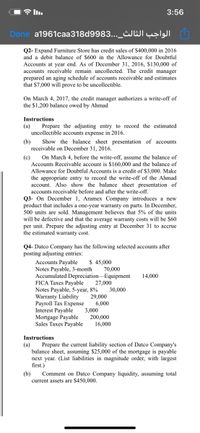
FINANCIAL ACCOUNTING
10th Edition
ISBN: 9781259964947
Author: Libby
Publisher: MCG
expand_more
expand_more
format_list_bulleted
Concept explainers
Question

Transcribed Image Text:D l.
3:56
Done a1961caa318d9983..._¿JWIÇ̟IJI
Q2- Expand Furniture Store has credit sales of $400,000 in 2016
and a debit balance of $600 in the Allowance for Doubtful
Accounts at year end. As of December 31, 2016, $130,000 of
accounts receivable remain uncollected. The credit manager
prepared an aging schedule of accounts receivable and estimates
that $7,000 will prove to be uncollectible.
On March 4, 2017, the credit manager authorizes a write-off of
the $1,200 balance owed by Ahmad
Instructions
(а)
Prepare the adjusting entry to record the estimated
uncollectible accounts expense in 2016.
(b)
Show the balance sheet presentation of accounts
receivable on December 31, 2016.
(c)
On March 4, before the write-off, assume the balance of
Accounts Receivable account is $160,000 and the balance of
Allowance for Doubtful Accounts is a credit of $3,000. Make
the appropriate entry to record the write-off of the Ahmad
account. Also show the balance sheet presentation of
accounts receivable before and after the write-off.
Q3- On December 1, Aramex Company introduces a new
product that includes a one-year warranty on parts. In December,
500 units are sold. Management believes that 5% of the units
will be defective and that the average warranty costs will be $60
per unit. Prepare the adjusting entry at December 31 to accrue
the estimated warranty cost.
Q4- Datco Company has the following selected accounts after
posting adjusting entries:
Accounts Payable
$ 45,000
Notes Payable, 3-month
70,000
Accumulated Depreciation-Equipment
14,000
FICA Taxes Payable
27,000
Notes Payable, 5-year, 8%
29,000
6,000
3,000
200,000
16,000
30,000
Warranty Liability
Payroll Tax Expense
Interest Payable
Mortgage Payable
Sales Taxes Payable
Instructions
(а)
Prepare the current liability section of Datco Company's
balance sheet, assuming $25,000 of the mortgage is payable
next year. (List liabilities in magnitude order, with largest
first.)
(b)
Comment on Datco Company liquidity, assuming total
current assets are $450,000.
Expert Solution
This question has been solved!
Explore an expertly crafted, step-by-step solution for a thorough understanding of key concepts.
Step by stepSolved in 3 steps

Knowledge Booster
Learn more about
Need a deep-dive on the concept behind this application? Look no further. Learn more about this topic, accounting and related others by exploring similar questions and additional content below.Similar questions
- What is the ending balance of Allowance for Doubtful Accounts at December 31, 2018, after all entries and adjusting entries are posted? Also what the net realizable value of accounts receivable at December 31, 2018?arrow_forwardGive me correct answer with explanationarrow_forwardAB Co made a credit sale to DE Co for $200,000 on July 19x9. It is known that at the end of 19x9 there was an outstanding receivable of $47,000. Managementestimates that $25,000 will be uncollectible.In July 19x9 the collections department stated that a receivable of $5,000 was written off frombookkeeping because it is impossible to receive payment from DE Co. Unexpectedly monthOctober 19x9 DE Co pays its outstanding debt. Requested:Prepare the adjusting entries and the journals needed to record the above transactions properlythe backup method as well as the direct deletion method!arrow_forward
- Can you also send me how to do this one? 2. Refer to the data below for XYZ Corporation. Credit sales during 2018 850,000 Accounts Receivable—January 1, 2018 334,000 Collections from credit customers during 2018 725,000 Estimated uncollectible accounts based on an aging analysis 13,200 Customer accounts written off as uncollectible during 2018 12,000 Allowance for doubtful accounts 1,700(after write-off of uncollectible accounts) Answer the following questions using the above data: A. What is the balance of Accounts Receivable at December 31, 2018? B. If the aging approach is used to estimate bad debts, what should the balance in Allowance for Doubtful Accountsbe after the bad debts adjustment? C. If the aging approach is used to estimate bad debts, what amount should be recorded as bed debts expense for2018?arrow_forwardA company must decide between scrapping or reworking units that do not pass Inspection. The company has 10,000 defective units that have already cost $132,000 to manufacture. The units can be sold as scrap for $31,000 or reworked for $45,000 and then sold for $85,000. (a) Prepare a scrap or rework analysis of Income effects. (b) Should the company sell the units as scrap or rework them? (a) Scrap or Rework Analysis Revenue from scrapped/reworked units Cost of reworked units Income Incremental income (b) The company should: Scrap Reworkarrow_forwardProvide both Answerarrow_forward
arrow_back_ios
arrow_forward_ios
Recommended textbooks for you

 AccountingAccountingISBN:9781337272094Author:WARREN, Carl S., Reeve, James M., Duchac, Jonathan E.Publisher:Cengage Learning,
AccountingAccountingISBN:9781337272094Author:WARREN, Carl S., Reeve, James M., Duchac, Jonathan E.Publisher:Cengage Learning, Accounting Information SystemsAccountingISBN:9781337619202Author:Hall, James A.Publisher:Cengage Learning,
Accounting Information SystemsAccountingISBN:9781337619202Author:Hall, James A.Publisher:Cengage Learning, Horngren's Cost Accounting: A Managerial Emphasis...AccountingISBN:9780134475585Author:Srikant M. Datar, Madhav V. RajanPublisher:PEARSON
Horngren's Cost Accounting: A Managerial Emphasis...AccountingISBN:9780134475585Author:Srikant M. Datar, Madhav V. RajanPublisher:PEARSON Intermediate AccountingAccountingISBN:9781259722660Author:J. David Spiceland, Mark W. Nelson, Wayne M ThomasPublisher:McGraw-Hill Education
Intermediate AccountingAccountingISBN:9781259722660Author:J. David Spiceland, Mark W. Nelson, Wayne M ThomasPublisher:McGraw-Hill Education Financial and Managerial AccountingAccountingISBN:9781259726705Author:John J Wild, Ken W. Shaw, Barbara Chiappetta Fundamental Accounting PrinciplesPublisher:McGraw-Hill Education
Financial and Managerial AccountingAccountingISBN:9781259726705Author:John J Wild, Ken W. Shaw, Barbara Chiappetta Fundamental Accounting PrinciplesPublisher:McGraw-Hill Education


Accounting
Accounting
ISBN:9781337272094
Author:WARREN, Carl S., Reeve, James M., Duchac, Jonathan E.
Publisher:Cengage Learning,

Accounting Information Systems
Accounting
ISBN:9781337619202
Author:Hall, James A.
Publisher:Cengage Learning,

Horngren's Cost Accounting: A Managerial Emphasis...
Accounting
ISBN:9780134475585
Author:Srikant M. Datar, Madhav V. Rajan
Publisher:PEARSON

Intermediate Accounting
Accounting
ISBN:9781259722660
Author:J. David Spiceland, Mark W. Nelson, Wayne M Thomas
Publisher:McGraw-Hill Education

Financial and Managerial Accounting
Accounting
ISBN:9781259726705
Author:John J Wild, Ken W. Shaw, Barbara Chiappetta Fundamental Accounting Principles
Publisher:McGraw-Hill Education